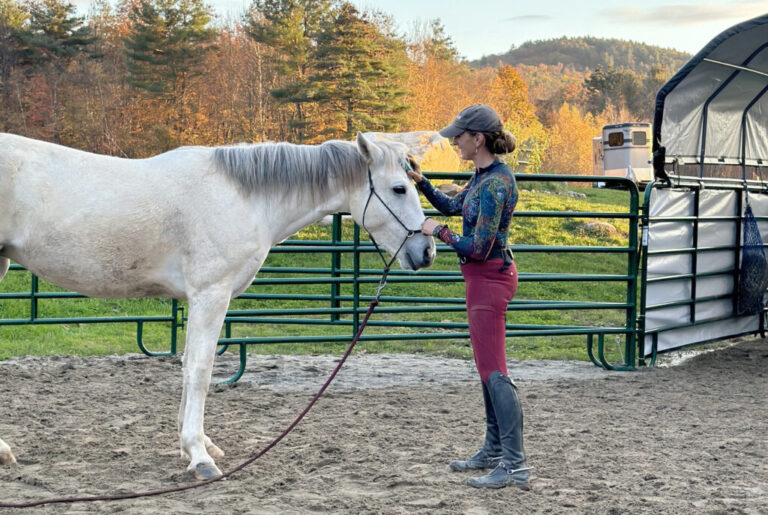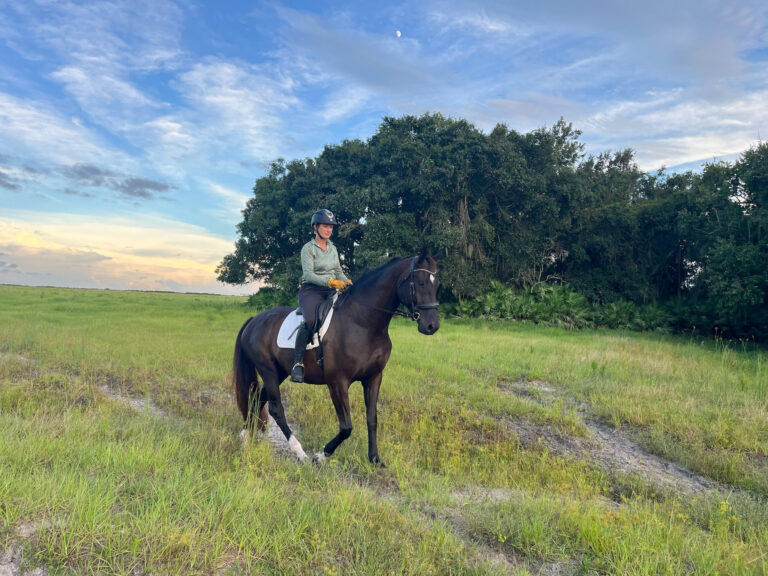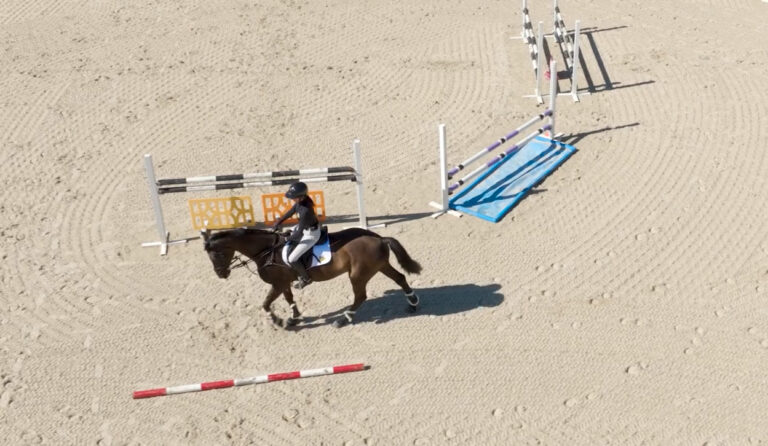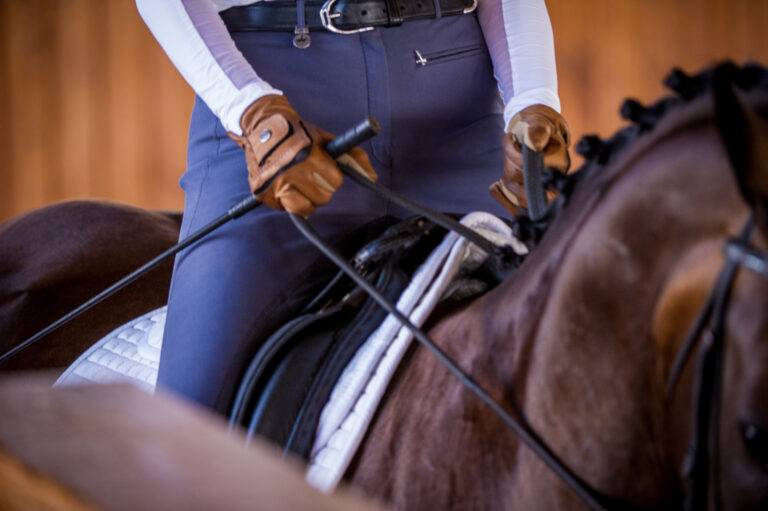When I was a student at Germany’s Westphalian Riding and Driving School, the instructors used cavalletti to train horses and riders. The horses learned rhythm, developed their muscles and improved their gaits. The riders learned to relax, follow the motion of their horses and not interfere.
Like all students, I rode, I did the exercises, I took notes, and I learned. And ever since, I have used cavalletti to train my horses—including Ahlerich, my great Olympic dressage partner. Now I want to show you how these simple wooden poles supported by cross-ends can help you and your horse strengthen your basics together. I’ll talk you through two straightforward exercises. In the first, you’ll walk and in the second you’ll trot a row of low, evenly spaced cavalletti. By the time you’ve mastered these exercises and made them part of your training program, your horse will have begun to develop his muscles naturally and symmetrically by repeatedly lifting his feet slightly higher than normal as he goes through the cavalletti, putting them down firmly and securely, and using both sides of his body evenly. He’ll loosen those muscles and ease stiffness by lowering his neck and relaxing his back. He’ll travel more safely and fluently over uneven ground as the work teaches him to balance and adjust his stride.
The simplicity of the two exercises will allow you to learn to be relaxed and supple, to stay in balance, to go forward with your horse and to give with your hands so he can use his head and neck freely. You’ll secure your leg and your stability, you’ll develop a feel for the swing in his back, and approaching the cavalletti, you’ll start to judge, and even adjust, his stride.
Getting Started
You’ll need a total of four cavalletti for this work. More can make your horse nervous; fewer won’t get the job done. The best cavalletti poles are 6 to 9 feet from end to end, heavy enough not to move if hit and rounded and hard so they don’t splinter and injure him if he knocks them. The cross-end supports let you set poles at three different heights, but for the simple exercises I’m going to give you, leave the poles at the lowest height, which just clears the ground. That’s high enough to make your horse pay attention and use himself but not so high that he’ll get excited or strain muscles as he works.
Make sure the footing of your work area is level and even, with no holes. I prefer sand to grass, which can be slippery, especially when wet, but it must have some give. A horse’s foot can buckle over on hard-packed sand, especially if his stride is uneven. Deep or soft sand can make the going more difficult than necessary, but at least it won’t jar his legs.
For this work, use your regular bridle and saddle, leave your stirrups at their normal length and protect your horse’s legs with splint boots or bandages; you don’t need bell boots unless he has a marked tendency to overreach.
I will tell you approximately how far apart to set the cavalletti for each exercise, but those distances are only guidelines. I don’t know how big your horse is, whether he has a long or short stride or whether he is bold, quick or quiet. Distance is so dependent on these variables that you will have to make adjustments—and since you cannot get much accomplished while you are dismounting, dragging heavy cavalletti around and mounting up again, you will need a knowledgeable helper. That helper will be able to do more for you than just set distances; she will be your eyes on the ground, telling you how your horse is responding to this new experience. Feel is always important and it’s one of the things these exercises will help you improve, but you can’t feel the expression on a horse’s face, the position of his tail or the way he’s using himself. You can’t see his rhythm or his stride, and you can’t always be sure whether his back is swinging or staying rigid.
Limit your cavalletti sessions to about 10 minutes twice a week. More could make your horse bored or sour, and spending too much time on this work could mean not enough time for all the other things you want to learn (leg-yield, following the inside leg, following the outside leg, half-halting, round circles, correct serpentines …). Cavalletti are valuable, but they are just part of your training program.
If your horse has been in his stall for 23 hours, he will need to burn off some “go” before work; you want him relaxed and listening, not bucking over the cavalletti. Turn him out if you have the time and you have the paddock, or take the edge off during your warm-up at the trot, suppling and relaxing him by going long and low and forward. When you put your leg on him and he doesn’t run, he’s probably ready to work. Give him a brief break, then begin.
Exercise 1: At the Walk
For our purposes, we will arrange the cavalletti in a straight line on the track where your horse won’t be so tempted to run out—good if you’re a beginner. Start by having your helper place a single cavalletti perpendicular to and touching the rail. If your horse is green, set wings on the open end at an angle to the cavalletti. Now ask him to move forward in a long, rhythmic, relaxed walk, the gait in which he has the most confidence when you are riding him. He should feel busy and active, as if you were hacking cross country. In Germany, we call this feeling schwung, a term usually translated as “impulsion,” but it means impulsion plus suspension, elevation and an increased swing in his back, so that the movement goes over the swinging back and the shoulders and down to the bit.
Come along the track toward the cavalletti, hold your hands low on your horse’s withers, relax your wrists and encourage him (by keeping absolutely loose reins with no contact) to give you that long, stretched, forward and down feel. Do as little as possible to influence him with your aids at this point—you don’t want to interfere with his ability to relax. Just encourage him with your voice, and incline the upper part of your body a little bit into the forward position so that if he jumps unexpectedly, you won’t come down on his back or get left behind.
As your horse walks over the cavalletti, focus on feeling his motion and allowing your body to follow it. This is the start of establishing a truly rhythmic stride. When your helper says, “That looks good,” hold the feel in your mind so you’ll remember what “good” feels like. And keep your horse straight. From the very beginning, he must learn that he may not wander. If he stumbles and loses his balance, remember that balance has to be learned and few horses are born clever. Just stay relaxed.
If your horse jumps the cavalletti or trots away from it, quietly bring him back to the walk and touch his neck with the flat of your hand to tell him what a good boy he is and how well he’s doing—after all, he did cross it.
Turn around and come again. This time your horse should feel as if he is saying “Wow, I can do this.” If he still seems a bit nervous or uncertain, continue back and forth over the single pole until he’s completely relaxed and calm. When he accepts the cavalletti calmly, have your helper add two more cavalletti, each set at a distance of about 3 feet, adjustable within a range of 2 feet 8 inches to 3 feet 3 inches, which should allow him to walk comfortably and actively. If he keeps tripping and stumbling and cannot find a rhythm, the cavalletti are probably too close; if he tries to put in an extra step, they are too far apart. Why go from one cavalletti to three, instead of increasing one at a time? Two cavalletti may tempt your horse to jump; three cavalletti will make him say “I can’t jump that; I guess I’m supposed to walk through again.”
When your horse feels as if he knows what he has to do on a loose rein and is doing it confidently and happily, shorten the reins and take up a light, steady, even, conversational connection with his mouth. Shorten his neck a little, push with your seat, create energy by lightly but evenly embracing his sides with your legs and ease the feel in your fingers slightly, as if inviting him to gently take the reins from you. In Germany, we say Zügel aus der ahdn kauen lassen—“allow the reins to be chewed from the hand.” His nose moves forward and downward, his neck rounds and he walks with complete relaxation.
When your horse does three cavalletti calmly forward and well, add the fourth. Now as you go back and forth, start focusing on the length of his stride and how a feel of it helps you predict when and where he’s going to step over the first cavalletti. The feel is crucial: It’s the start of accuracy, whether you’re trying to refine your dressage movements, sharpen your transitions at the letters or find comfortable jumping distances. You still want that stretched, forward, downward look, but you also want enough of a connection to be able to predict and adjust his arrival at the first pole. If he’s going to get there too early and stumble in, shorten the walk by keeping your leg and seat active, squeezing your shoulders together and tightening your spine in a half-halt. If you feel he is going to be too late and will have to reach, lengthen his stride by lowering your hands, squeezing with your legs and pushing with your seat. Whatever adjustments you make, do them smoothly and in the rhythm you’ve established.
See also: Cavalletti Training for Every Horse and Discipline with Ingrid Klimke
Exercise 2: At the Trot
If you were starting this exercise at the trot, I would have you build from one cavalletti. But since you’ve laid a foundation at the walk, you are prepared to trot four cavalletti right away. Space them 4½ feet apart, adjustable within the range of 4 feet 3 inches to 4 feet 10 inches. And set them so that the first cavalletti is about 30 feet from the corner: enough of an approach to straighten your horse but no more. The more time he has to look at and worry about the obstacles coming up, the faster and more nervous he may get.
To gain the greatest benefits from trot work, your horse needs to be carrying himself in balance, neither leaning on your hands nor hanging behind your leg and not behind the vertical. Pick up a working trot, rising, that is rhythmic and active behind but that gives you the feel of slow motion. It is with this slow motion that the elevation of the stride comes.
To create this rhythmic, active trot, you will need a little more drive than you did at the walk. Lay your leg against your horse’s side, keep your foot almost parallel and quietly move your lower leg a little so that your ankle and heel come in. With your hands, maintain a consistent pleasant feel, neither heavy nor light.
Trot slowly into the cavalletti, continue to post lightly, keep your horse straight, incline your body slightly forward and keep your hands low and steady on both sides of his withers. He may raise his head a bit simply because he wants to see what lies ahead—but as long as he doesn’t hollow, don’t try to prevent it—you’ll only make him fight you and you’ll lose his confidence. Going over the cavalletti will remind him to bring his head down and arch his back on his own accord.
This is when you see what cavalletti are all about. As your horse trots through, stepping a little higher or maybe striding slightly bigger to accommodate the distance between the poles, his movement will take more effort.
Praise your horse on the other side, touch his neck to make him happy and willing, reverse and come again. Keep the rhythm. If he repeatedly doesn’t get the striding right, try a bit more pace or have your helper adjust the distance. Then go with him as he trots through—and by all means, take a hold of his mane if you need to. When he can trot to and through the cavalletti with a lowered position to his neck, you’re finished with cavalletti for the day.
If you come back to these two simple exercises regularly, you will continue to improve your position and sharpen your ability to influence your horse’s stride. He will continue to develop his balance and build his muscles correctly and evenly. Best of all, the exercises will make both of you happy about your work—and only happy riders and happy horses can improve themselves enough to become willing, confident partners.
About Reiner Klimke
One of the most illustrious and versatile horsemen of his time, Reiner Klimke, who passed away in August 1999, emphasized going back to the basics in his training. The German native gave generous praise to his horses so that they enjoyed their sessions. In his training and coaching, he focused on one thing at a time so that horses and riders could understand exactly what they were being asked.
Early in his career, Dr. Klimke competed for his country as an Olympic three-day-event rider before embarking on an international dressage career that lasted for more than 30 years and garnered German, European and world championships. He won six Olympic gold medals, including both individual and team gold medals at the 1984 Los Angeles Olympic Games with his most famous equine partner, Ahlerich.
A man of almost bottomless energy, he rode as many as five horses a day at home in Münster, tended to the demands of a busy law practice and served as a member of the Westphalian parliament. He also wrote, produced videos, taught and gave clinics around the world. His book Cavalletti was first published in Germany in 1966. Its latest reprint in 2000 included a section on jumping written by his daughter, Olympic eventing gold medalist Ingrid Klimke.
This article appeared in the September 2013 issue.








